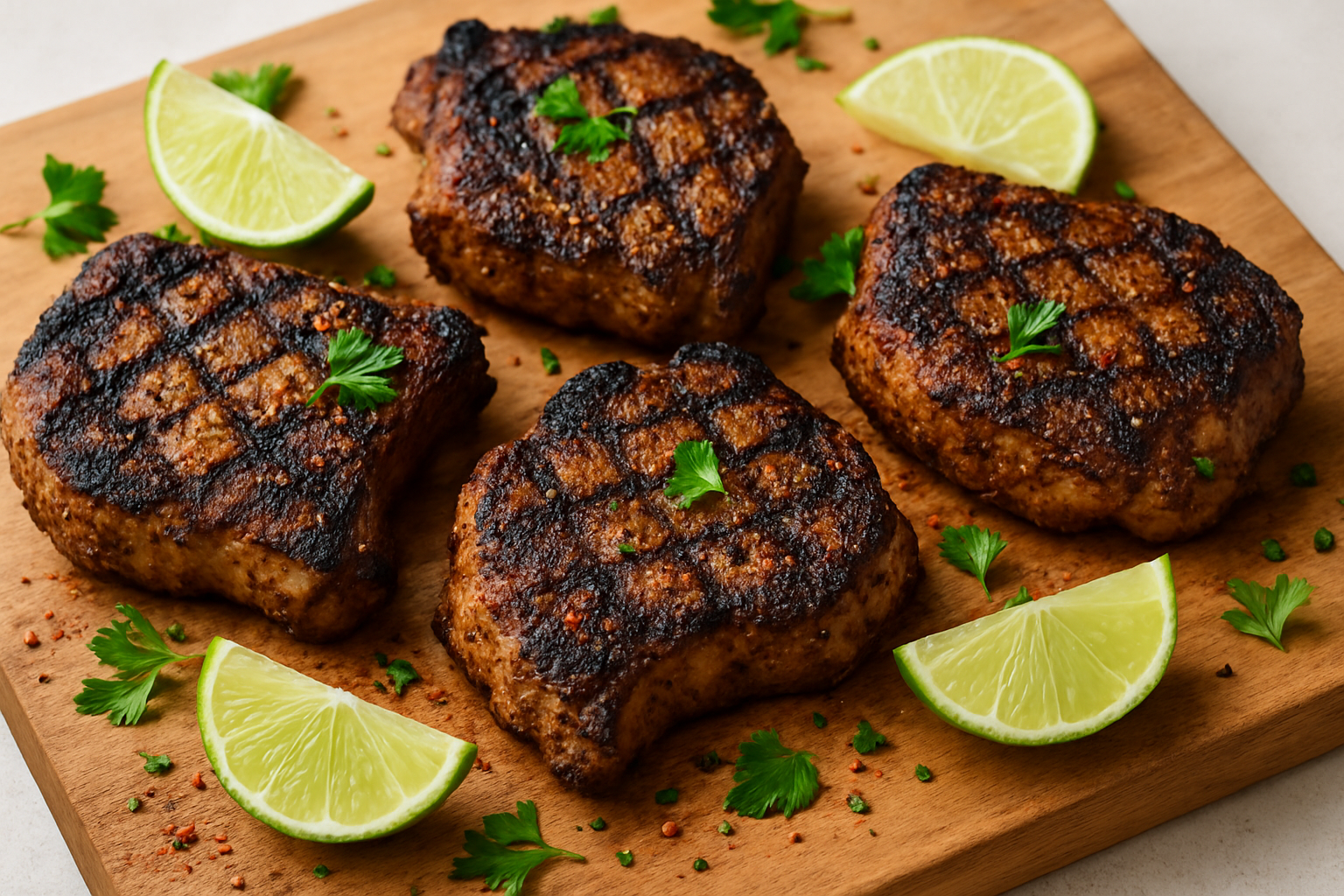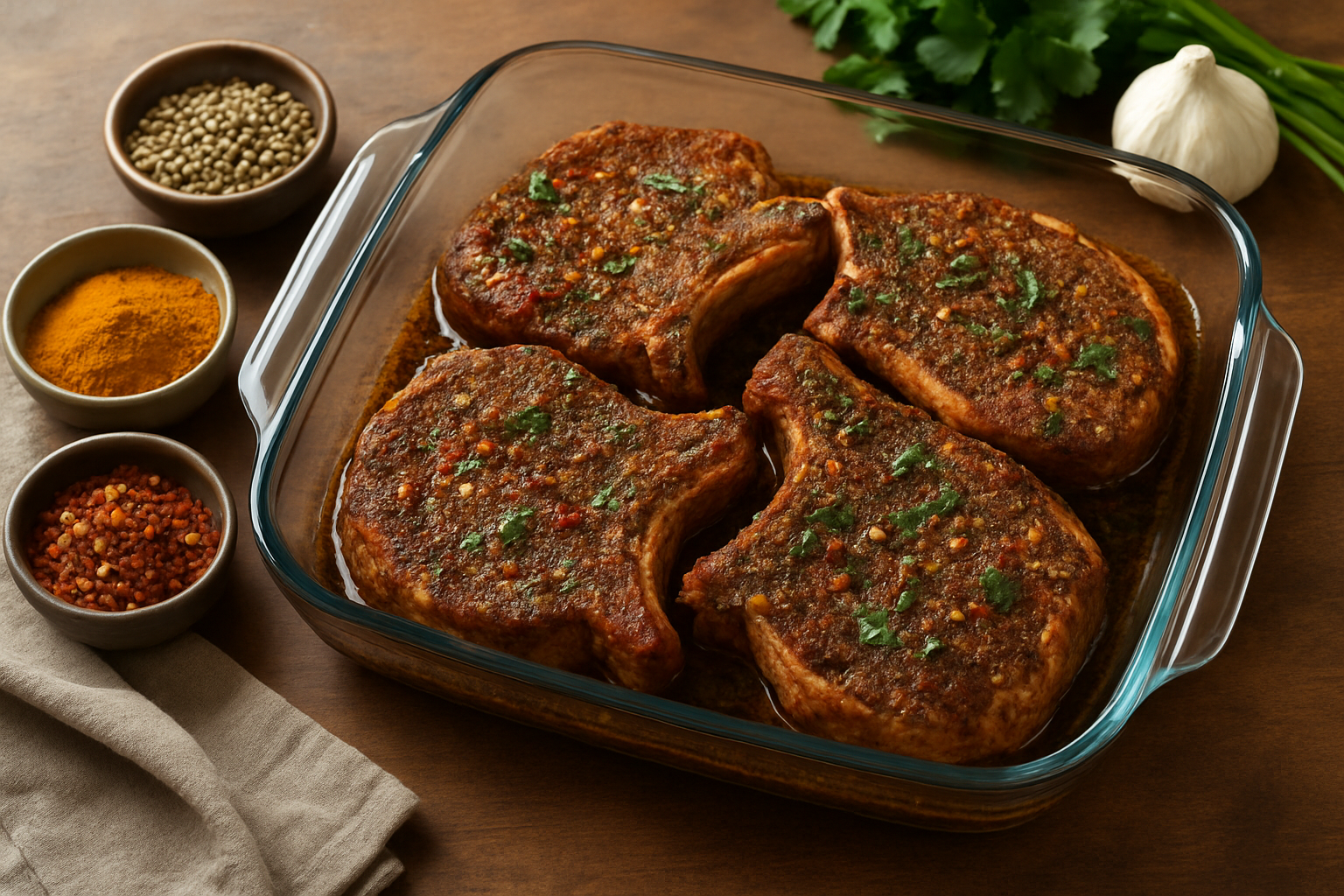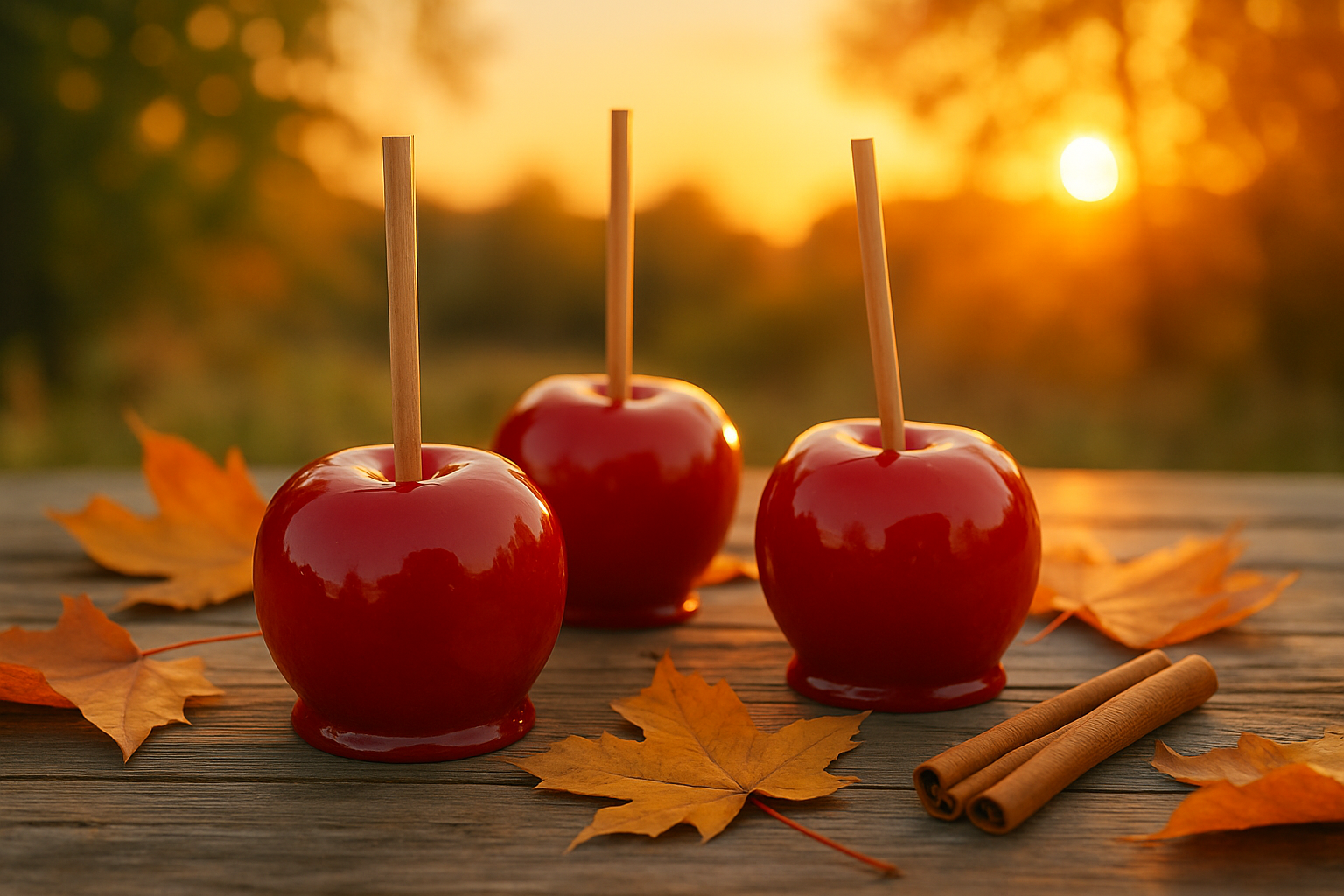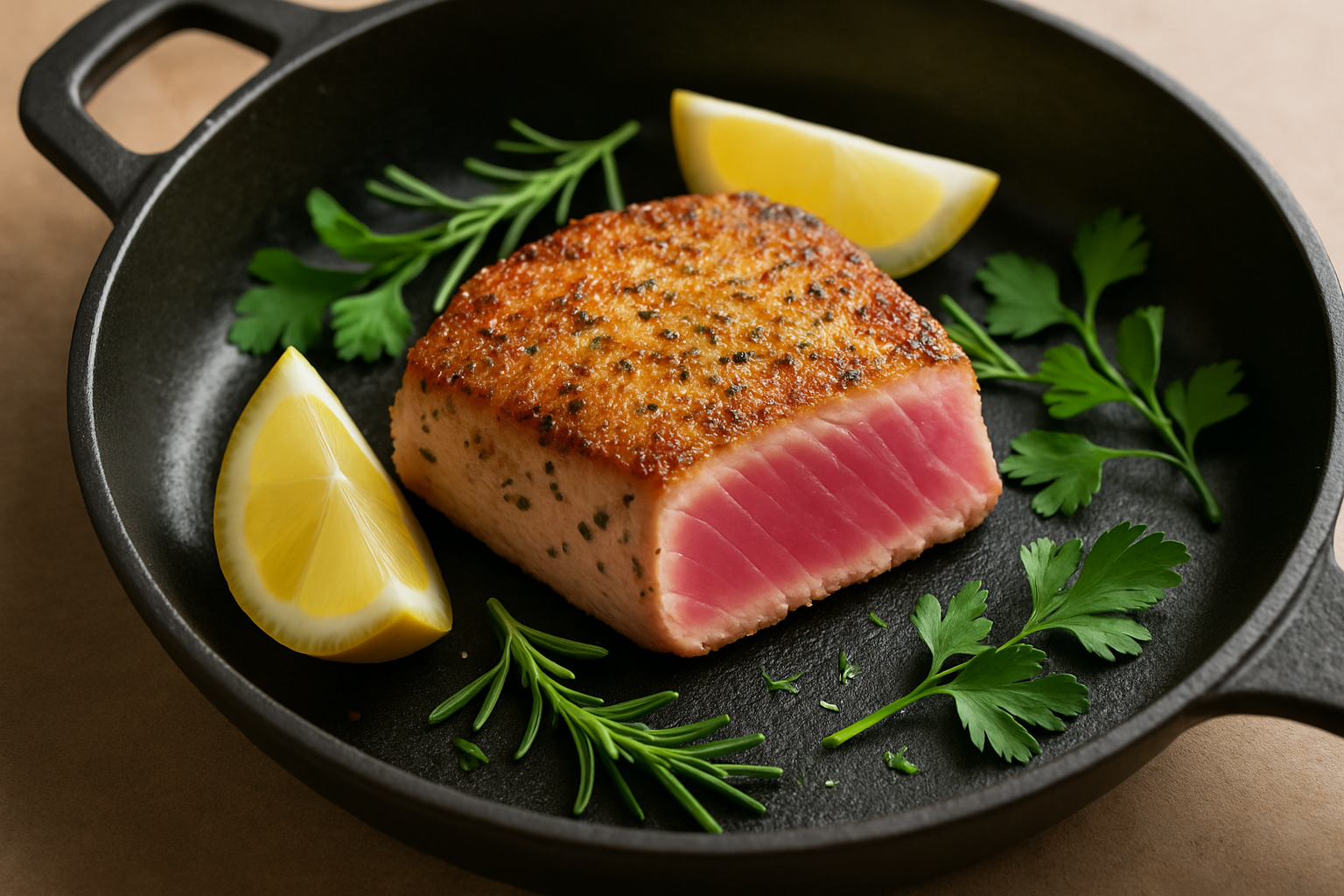How to Make Caribbean Jerk Pork Chops at Home

This article guides you through crafting vibrant Caribbean jerk pork chops in your own kitchen covering all the essentials from spice blends to the perfect side dishes.
- Dive into the authentic blend of spices that give Caribbean jerk its unmistakable punch with stars like allspice and fiery Scotch bonnet peppers stealing the show.
- Learn the art of choosing pork chops that aren’t just any chops—they soak up flavors like a dream and stay tender through every minute of marinating.
- Follow straightforward step-by-step instructions for marinating and cooking whether you’re firing up the grill or going the pan-fry route to lock in that juicy goodness.
- Uncover classic Caribbean sides such as fragrant rice and peas or crispy fried plantains that perfectly complement those bold and spicy pork chops.
Caribbean jerk pork chops bring a vibrant punch of spicy and smoky flavors that can instantly liven up any meal.
Jerk seasoning hails from Jamaica and blends local spices with African and European influences, creating that unmistakable Caribbean flavor that’s hard to forget.
Taking a Closer Peek at What Goes into Those Caribbean Jerk Pork Chops
Jerk pork chops owe their bold character to a lively mix of spices like allspice and Scotch bonnet peppers, thyme and garlic.
| Ingredient | Role in the Recipe | Substitutions |
|---|---|---|
| Allspice | Lends a warm, sweet, and spicy kick that is absolutely key for that signature jerk seasoning flavor | Ground cloves or cinnamon |
| Scotch bonnet peppers | Pack a punch with authentic fiery heat, paired with a delightfully fruity aroma to boot | Habanero peppers |
| Thyme | Brings fresh, herbal brightness that really lifts the whole dish | Oregano or marjoram |
| Garlic | Adds a savory depth that quietly ties everything together | Garlic powder (use sparingly) |
| Ginger | Offers sharp, zesty undertones that wake up the palate | Ground allspice or galangal |
| Brown sugar | Sweetens things up and perfectly balances out the heat, keeping it all from going off the rails | Honey or molasses |
| Soy sauce | Injects a hit of umami and saltiness that rounds out the flavors | Tamari or Worcestershire sauce |
| Green onions | Provide a fresh, mild onion note that’s just enough without stealing the show | Shallots or chives |
| Lime juice | Adds a bright, tangy acidity that cuts through richer flavors | Lemon juice |
Choosing the Right Pork Chops for Your Jerk Recipe Because Not All Chops Are Created Equal
Picking the right cut of pork chop can make all the difference when it comes to soaking up flavors and ending up tender as can be. Bone-in chops usually steal the show with their juiciness and rich flavor, while leaner cuts might cook faster but can easily tiptoe into dryness if you’re not careful.
- Bone-in rib chops pack a punch of flavor and usually stay nice and juicy, which is always a win in my book.
- Loin chops are lean and tender, but you’ve got to keep a close eye on them while cooking to avoid that dreaded dryness.
- Center-cut chops hit that sweet spot, balancing tenderness with just the right amount of flavor soaking in.
- Country-style chops come from the shoulder and bring a rich taste to the party, standing up bravely to bold marinades.
- Thick-cut chops are perfect for those longer marinating and grilling sessions, letting those jerk flavors really sink in deep.
Step-by-Step Guide to Preparing and Marinating Caribbean Jerk Pork Chops That Will Make Your Taste Buds Dance
Really nailing that rich jerk flavor soaking deep into the meat requires giving the marinade plenty of time. Pork chops in my experience come out best when they’ve had at least 4 hours to soak up all that goodness. Overnight is even better if you can swing it.
Whip up your jerk marinade. Toss fresh garlic, ginger, Scotch bonnet peppers, allspice, thyme, brown sugar, soy sauce, green onions and lime juice into a blender and pulse until it’s smooth.
Pat those pork chops dry with paper towels. This step helps the marinade cling perfectly.
Slide the pork chops into a resealable plastic bag or a shallow dish whichever you prefer.
Pour the flavorful marinade over the chops, making sure every piece gets an even coat.
Seal the bag tightly or cover the dish snugly with plastic wrap to keep the delicious juices locked in.
Let the pork chops soak up those amazing flavors in the fridge for at least 4 hours. Overnight is better if you can swing it. Turn the chops now and then so the marinade spreads its magic evenly.
Take the pork chops out about 30 minutes before you fire up the grill or stovetop to let them come to room temperature. This trick helps them cook more evenly without surprises.
Save a small bit of the marinade for basting while cooking but be careful. It shouldn’t have had contact with raw meat to keep things safe and sound.

Marinated Caribbean jerk pork chops ready to be cooked
Cooking Techniques Friendly Showdown Between Grilling and Pan-Frying Caribbean Jerk Pork Chops
Grilling brings out that authentic smoky flavor and a satisfying charred texture that truly nails the classic jerk taste. On the other hand, pan-frying lets you control the heat and stay cozy indoors. It crafts a lovely caramelized crust while keeping the meat tender and juicy.
- Grilling really brings out rich natural smoky flavors and is a top choice for outdoor cooking and lively get-togethers.
- Pan-frying gives you a lot of control over the heat and is a handy option when firing up the grill isn’t possible.
- Grilling demands careful attention because flare-ups can sneak up on you and leave the meat dry.
- Pan-frying tends to deliver a nice even crust but often misses that deeper smoky kick.
- Both methods benefit greatly from basting with some reserved marinade. It’s a simple trick to keep things juicy and packed with flavor.
Cook pork chops over medium-high heat for about 4 to 6 minutes on each side, depending on their thickness. I’ve found that using a meat thermometer to hit an internal temperature of 145°F really does the trick for keeping them tender.
Serving Suggestions and Side Dishes That Pair Perfectly with Caribbean Jerk Pork Chops (Because Good Food Deserves Great Company)
Balancing those boldly flavored jerk pork chops with some classic sides turns the meal into a real crowd-pleaser.
- Rice and peas simmered in coconut milk give it an irresistibly creamy texture and a touch of gentle sweetness like a warm hug.
- Fried plantains are golden and caramelized and add a sweet counterpoint that perfectly tames the spicy kick of the pork.
- Crisp coleslaw tossed in a zesty lime dressing brings a refreshing crunch and a tang that wakes up your taste buds.
- Steamed or sautéed veggies like callaloo, okra or cabbage offer earthy undertones that round out the meal beautifully.
- A bright tropical fruit salsa with mango, pineapple and lime instantly lifts the dish and pairs like a charm with all that heat.
Handy Tips for Storing and Reheating Leftover Jerk Pork Chops That'll Keep Them Tasty
Storing your Caribbean jerk pork chops the right way is key to keeping their bold flavors alive and kicking while making sure they don’t dry out on you. When it comes to reheating, I’ve found that gentle methods like warming them slowly in the oven or steaming on the stove do a great job of locking in moisture and preserving those delicious spices.
- Keep pork chops stored in an airtight container in the fridge for up to 3 to 4 days. This is enough time to enjoy them without feeling rushed.
- If you need to store them longer, wrap the chops snugly in foil and plastic wrap. Then place them in the freezer where they will stay good for up to 3 months.
- When thawing, it is best to take it slow and let the frozen chops thaw overnight in the fridge to maintain their texture.
- For reheating, preheat your oven to 325°F and wrap the chops tightly in foil. This step keeps them moist and prevents drying out.
- You can also warm them gently on the stove over low heat with a splash of water. Cover the pan so the chops steam slightly instead of drying out like jerky.
Frequently Asked Questions
Can I substitute Scotch bonnet peppers if I cannot find them?
Absolutely, habanero peppers make a great alternative if Scotch bonnets are hard to find. If you want milder heat, jalapeños or a pinch of cayenne pepper will work well. Be careful with the amounts because Scotch bonnets are very spicy. For a much milder option, bell peppers with a sprinkle of chili flakes keep things flavorful though the taste will be different.
How long can I marinate the pork chops without over-tenderizing?
You should marinate them from 4 to 24 hours. After 24 hours the lime juice's acidity breaks down the meat too much which can leave it mushy and unpleasant. In my experience, marinating overnight (about 8 to 12 hours) is ideal for deep flavor without compromising texture. Short on time? Four hours still works well especially if you score the meat a bit to help the flavors penetrate.
Is it safe to baste with the reserved marinade?
You can baste with the reserved marinade but only if you boil it for 2 to 3 minutes first to kill bacteria from the raw meat. Another tip is to set aside some marinade before adding the pork chops so you do not worry about contamination. Basting adds a great layer of flavor but food safety is important — never reuse marinade that touched raw pork unless properly cooked.
Can I bake jerk pork chops instead of grilling or pan-frying?
Baking is definitely a good option. Bake them at 375°F (190°C) for 20 to 25 minutes, turning halfway to cook evenly. If you want some crispiness, broil them for 2 to 3 minutes at the end. While you will not get the smoky char from grilling, baking is an easy and hands-off way to prepare tasty chops. Just brush them with marinade or a little oil to keep them from drying out — it really helps.
What’s the best way to tone down the spice for kids or sensitive palates?
You can halve or skip the Scotch bonnets entirely, leave out the cayenne, and add more brown sugar or a splash of orange juice to balance the heat — I’ve found this softens the spice. Pairing the chops with cooling sides like coconut rice or avocado salad works great too. And if people want more heat, they can always add it later.
Why are my jerk pork chops turning out dry?
Dry chops usually mean they have been overcooked. A meat thermometer is really helpful; aim for an internal temperature of 145°F and then let the chops rest for about 5 minutes before serving. Thicker cuts over an inch tend to stay juicy better. If you are using lean loin chops, try not to cook them over very high heat — bone-in or shoulder cuts hold moisture better. Also, frequent basting during cooking helps keep the meat moist.





